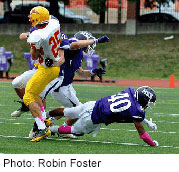
SATURDAY, Sept. 27, 2014 (HealthDay News) — Young athletes hitting the playing fields this fall should be reminded that aches and pains might signal an undiagnosed sports injury, experts say.
And “playing through the pain” could make an undetected injury even worse, according to the American Academy of Orthopaedic Surgeons (AAOS) and the American Orthopaedic Society for Sports Medicine.
“Overuse injuries are the most common types of sports-related injuries,” Dr. Michael George, a spokesman for the AAOS, said in an organization news release.
“Oftentimes the initial aches and pains felt during the progression of an injury are overlooked by young athletes,” George said. “It’s essential to teach them about the importance of informing a coach or parent about pain, because an undiagnosed injury can become more severe in the long run.”
Football, soccer, volleyball and cheerleading are some popular fall sports. Among kids aged 5 to 18, football resulted in about 880,000 injuries in 2013, according to the Consumer Product Safety Commission (CPSC). That same year, the CPSC noted, almost 434,000 kids were treated for soccer injuries, nearly 99,900 suffered cheerleading-related injuries and more than 94,000 young people were hurt playing volleyball.
Taking some precautions, however, can help keep kids safe on the field or on the court, according to experts. In addition to not ignoring pain, they advised young people to follow these safety tips:
- Don’t skip the warm-up or cool-down. Before and after practice, it’s important to do some low-impact exercises such as walking or biking.
- Add strength training and stretching. For stretching to be safe and effective, hold the pose for 10 to 12 seconds and do not push your body beyond the point of resistance.
- Stay hydrated. This is key to minimizing muscle cramps. If you feel thirsty, you’ve waited too long to drink fluids.
- Consider your surface. Be sure you are not playing on an unsafe surface that is not in good condition.
- Check your equipment. It’s important to wear all necessary and recommended protective athletic gear, such as cleats, pads, a helmet and a mouth guard. Be sure all of your gear fits properly.
- Be flexible. If possible, play more than one position or try new sports during the off-season. This will help prevent overuse injuries.
- Consider the weather. Rain or snow could lead to wet and slippery turf that can increase the risk for injuries. Be aware of how the weather has affected conditions on the playing field.
- Listen to your body. Avoid overtraining. If you develop any pain or discomfort, reduce the duration and intensity of your workout to avoid injury or burnout.
More information
The U.S. National Institute of Arthritis and Musculoskeletal and Skin Diseases has more about sports injuries.
Copyright © 2025 HealthDay. All rights reserved.

